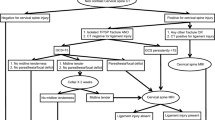Abstract
Purpose
Although many reports advocate computed tomography (CT) as the initial surveillance tool for occult cervical spine injury (CSI) at the emergency department (ED), the role of a lateral cervical spine radiograph (LCSX) has still not been replaced. We hypothesized that the increased width of the prevertebral soft tissue on an LCSX provides helpful information for selecting the high-risk patients who need to be evaluated with more accurate diagnostic tools.
Methods
This was a retrospective and consecutive series of injured patients requiring cervical spine evaluation who were first imaged with three-view plain films at the ED. The prevertebral soft tissue thickness (PVST) and ratio of prevertebral soft tissue thickness to the cervical vertebrae diameter (PVST ratio) were calculated on the LCSX. Suspicion of CSI was confirmed by either CT or magnetic resonance imaging (MRI) scans.
Results
A total of 826 adult trauma patients requiring cervical spine evaluation were enrolled. The C3 PVST and PVST ratio were significantly different between patients with or without upper cervical area injury (UCAI, 8.64 vs. 5.49 mm, and 0.394 vs. 0.276, respectively), and, likewise, the C6 PVST and PVST ratio for patients with or without lower cervical area injury (LCAI, 16.89 vs. 14.66 mm, and 0.784 vs. 0.749, respectively). The specificity was greater than 90 % in predicting UCAI and LCAI when combining these two parameters.
Conclusions
This method maximizes the usefulness of LCSX during the initial assessment of a conscious patient with blunt head and neck injury, especially for the identification of high-risk patients requiring prompt CT or MRI; on the other hand, it prevents the overuse of these high-cost imaging studies as initial diagnostic tools.


Similar content being viewed by others
References
Davis JW, Phreaner DL, Hoyt DB, Mackersie RC. The etiology of missed cervical spine injuries. J Trauma. 1993;34:342–6.
Grossman MD, Reilly PM, Gillett T, Gillett D. National survey of the incidence of cervical spine injury and approach to cervical spine clearance in U.S. trauma centers. J Trauma. 1999;47:684–90.
Platzer P, Hauswirth N, Jaindl M, Chatwani S, Vecsei V, Gaebler C. Delayed or missed diagnosis of cervical spine injuries. J Trauma. 2006;61:150–5.
Fisher A, Young WF. Is the lateral cervical spine x-ray obsolete during the initial evaluation of patients with acute trauma? Surg Neurol. 2008;70:53–7.
Mathen R, Inaba K, Munera F, Teixeira PG, Rivas L, McKenney M, Lopez P, Ledezma CJ. Prospective evaluation of multislice computed tomography versus plain radiographic cervical spine clearance in trauma patients. J Trauma. 2007;62:1427–31.
Steigelman M, Lopez P, Dent D, Myers J, Corneille M, Stewart R, Cohn S. Screening cervical spine MRI after normal cervical spine CT scans in patients in whom cervical spine injury cannot be excluded by physical examination. Am J Surg. 2008;196:857–63.
Diaz JJ Jr, Aulino JM, Collier B, Roman C, May AK, Miller RS, Guillamondegui O, Morris JA Jr. The early work-up for isolated ligamentous injury of the cervical spine: does computed tomography scan have a role? J Trauma. 2005;59:897–904.
American College of Surgeons Committee on Trauma. Advanced trauma life support manual. 8th ed. Chicago: American College of Surgeons; 2008. p. 166–8.
British Trauma Society. Guidelines for the initial management and assessment of spinal injury. British Trauma Society, 2002. Injury. 2003;34:405–25.
Pasquale M, Fabian TC. Practice management guidelines for trauma from the Eastern Association for the Surgery of Trauma. J Trauma. 1998;44:941–56.
Griffen MM, Frykberg ER, Kerwin AJ, Schinco MA, Tepas JJ, Rowe K, Abboud J. Radiographic clearance of blunt cervical spine injury: plain radiograph or computed tomography scan? J Trauma. 2003;55:222–6.
Muchow RD, Resnick DK, Abdel MP, Munoz A, Anderson PA. Magnetic resonance imaging (MRI) in the clearance of the cervical spine in blunt trauma: a meta-analysis. J Trauma. 2008;64:179–89.
DeBehnke DJ, Havel CJ. Utility of prevertebral soft tissue measurements in identifying patients with cervical spine fractures. Ann Emerg Med. 1994;24:1119–24.
Keats TE, Sistrom C. Atlas of radiologic measurement. St. Louis: Mosby; 2001. p. 87–8.
Nuñez DB Jr, Quencer RM. The role of helical CT in the assessment of cervical spine injuries. AJR Am J Roentgenol. 1998;171:951–7.
Lufkin RB, Borges A, Villablanca P. Teaching atlas of head and neck imaging. New York: Thieme; 2000. p. 174–6.
Herr CH, Ball PA, Sargent SK, Quinton HB. Sensitivity of prevertebral soft tissue measurement of C3 for detection of cervical spine fractures and dislocations. Am J Emerg Med. 1998;16:346–69.
Templeton PA, Young JW, Mirvis SE, Buddemeyer EU. The value of retropharyngeal soft tissue measurements in trauma of the adult cervical spine. Cervical spine soft tissue measurements. Skeletal Radiol. 1987;16:98–104.
Dai LY. Significance of prevertebral soft tissue measurement in cervical spine injuries. Eur J Radiol. 2004;51:73–6.
Penning L. Prevertebral hematoma in cervical spine injury: incidence and etiologic significance. AJR Am J Roentgenol. 1981;136:553–61.
Daffner RH, Sciulli RL, Rodriguez A, Protetch J. Imaging for evaluation of suspected cervical spine trauma: a 2-year analysis. Injury. 2006;37:652–8.
Sistrom CL, Southall EP, Peddada SD, Shaffer HA Jr. Factors affecting the thickness of the cervical prevertebral soft tissues. Skeletal Radiol. 1993;22:167–71.
Rojas CA, Vermess D, Bertozzi JC, Whitlow J, Guidi C, Martinez CR. Normal thickness and appearance of the prevertebral soft tissues on multidetector CT. AJNR Am J Neuroradiol. 2009;30:136–41.
Conflict of interest
Jiun-Pyng Shiau, Cheng-Chih Liao, and the other co-authors did not receive any funding for this work and declare no conflicts of interest with respect to the present work.
Author information
Authors and Affiliations
Corresponding author
Additional information
This manuscript has not been published nor is under consideration by another journal. This study has been approved by the Institutional Review Board (IRB) committee of Chang Gung Memorial Hospital.
Rights and permissions
About this article
Cite this article
Shiau, JP., Chin, CC., Yeh, CN. et al. Does the ratio and thickness of prevertebral soft tissue provide benefit in blunt cervical spine injury?. Eur J Trauma Emerg Surg 39, 297–303 (2013). https://doi.org/10.1007/s00068-013-0270-x
Received:
Accepted:
Published:
Issue Date:
DOI: https://doi.org/10.1007/s00068-013-0270-x




